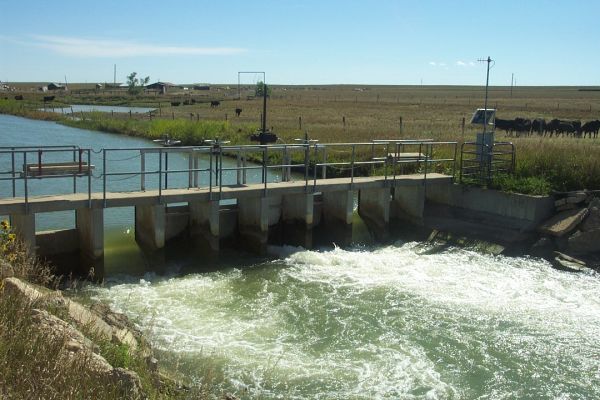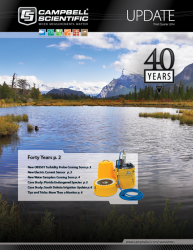
The semiarid region just north of the Black Hills in western South Dakota has vast stretches of tablelands that require carefully monitored irrigation for agricultural development. The land north of the Belle Fourche River comprises mainly sticky gumbo soil that retains water, whereas the land south of the river has sandy loam that requires frequent watering.
在承认this region’s complex irrigation needs, the Bureau of Reclamation established the Belle Fourche Irrigation District (BFID) for the care, operation, and maintenance of a gravity-fed, canal-based irrigation system. This system delivers water to over 202 km2(50,000 acres) of irrigated cropland using a diversion dam, two primary canals (North and South), an inlet canal, and the Belle Fourche Dam.
Because this region faces recurring drought, water conservation is critical to ensure a sufficient, available supply for irrigation needs throughout the district. The goal of BFID was to reduce their canal water-level fluctuations, thereby reducing water loss and increasing delivery efficiency. To accomplish this, it was necessary to automate the BFID’s canal check structures.
BFID contracted with RESPEC, an integrated consulting and services firm, to assist with the project coordination, installation, advising, system configuration, and troubleshooting. In 2006, RESPEC began installing water-level sensors, gate-height sensors, and gate actuators in combination with Campbell Scientific dataloggers (CR1000, CR850, and CR200X).
The automated check gates maintain a constant upstream water level throughout the canal system, which promotes more efficient water delivery to farmer turnouts and lateral head gates. The desired lateral flow is programmed into the datalogger using LoggerNet, and the flow is measured either upstream or downstream of the gate using a water-level sensor.
RESPEC set up and coordinated an extensive radio communication network across the BFID using RF450 spread-spectrum radios. With this network, selected sites are monitored and controlled in real time from the BFID headquarters in Newell, South Dakota, or from anywhere throughout the BFID using a vehicle-mounted, mobile base station.
To assess and quantify the benefit of implementing the automated gates, RESPEC conducted an analysis of the Vale Lateral, which is a major lateral on the South Canal. In 2005, before the check-gate automation was implemented, the upstream canal level showed fluctuations greater than 0.3 m (1.0 ft). After the Vale gate was automated in 2006, the canal level showed fluctuations within ±1.5 cm (±0.05 ft). Based on water-delivery records, the check-gate automation resulted in an 84 percent improvement in water-delivery efficiency. In 2007, a real-time automated head gate and sensors were installed on the Vale Lateral flume. This installation has an estimated loss reduction of approximately 4.3 million m3(3,460 acre-feet) per year, providing more water for distribution throughout the irrigation system or for recreational purposes at the reservoir. In addition, by reducing the amount of excess water, the amount of sediment picked up is also reduced. With less sediment discharged into the adjacent Belle Fourche River, water quality and fisheries are improved.
Since 2006, RESPEC has automated more than 50 canal check structures using a variety of Campbell Scientific dataloggers and an extensive RF450 radio network. The upgrades to the canal check structures have helped the BFID improve their water-delivery efficiency, continue to meet their district’s irrigation needs, and protect the Belle Fourche Reservoir for thousands of annual visitors.

